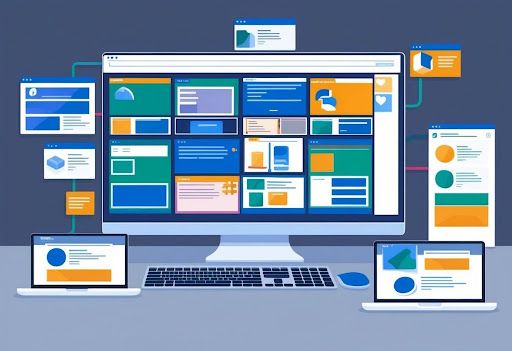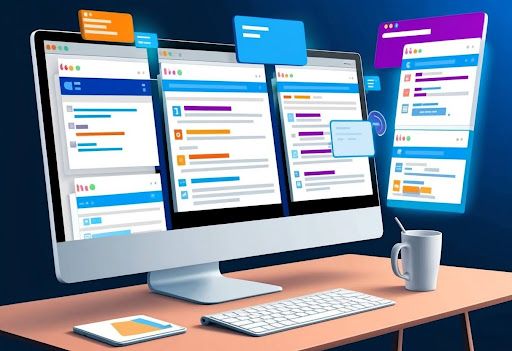Screenshots as Evidence: Automate Website Captures for Legal Documentation
By Eric Do Couto
Updated February 12, 2025

Screenshots as Evidence: Automate Website Captures for Legal Documentation

Screenshots are powerful visual documentation of online activities and content. They can also be legally valid evidence in litigation, particularly for cases involving digital content, intellectual property infringement, and website compliance.
Automated screenshot capture has transformed how businesses protect their interests and maintain compliance records. These digital snapshots create a permanent record of website content, user interactions, and online communications that can prove invaluable during legal proceedings.
Legal teams and compliance officers increasingly depend on systematic website documentation to construct strong cases and safeguard their clients' interests. The capability to capture and store digital evidence automatically saves countless hours while maintaining accuracy and reliability.
Key Takeaways
- Screenshots provide legally admissible evidence for digital content and online activities
- Automated capture systems ensure consistent and reliable documentation for legal proceedings
- Regular website archiving protects businesses against compliance issues and intellectual property disputes
The Fundamentals of Using Screenshots as Evidence
Screenshots are visual proof of digital events in legal proceedings and compliance documentation. Digital evidence requires careful handling, proper authentication, and consideration of legal rules to maintain admissibility.
Best Evidence Rule and Digital Forensics
The Best Evidence Rule applies differently to screenshots than traditional documents. Courts often require additional verification to prove the authenticity of digital content.
Digital forensics experts examine metadata, timestamps, and file properties to validate screenshot authenticity. This technical analysis helps establish the evidence's chain of custody and integrity.
Proper documentation of the screenshot capture process strengthens evidentiary value. This includes recording the date, time, device used, and the identity of the person taking the screenshot.
Authenticating Screenshots for Legal Proceedings
Screenshots must meet specific criteria for court admissibility. Key requirements include consent compliance and respect for privacy rights.
Authentication methods include:
- Digital signatures
- Timestamp verification
- Metadata analysis
- Expert testimony
- Chain of custody documentation
Courts examine whether screenshots accurately represent the original digital content. Any alterations or modifications must be disclosed and justified.
Security and Reliability Concerns
Protecting screenshot integrity requires robust security measures. Automated capture systems help maintain consistency and reduce manipulation risks.
Storage systems must protect against unauthorized access and tampering. Regular backups and redundant storage safeguard against data loss.
Common reliability challenges include:
- Image quality degradation
- Potential manipulation
- Missing context
- Incomplete metadata
Implementing standardized capture procedures helps address these concerns. Regular audits of screenshot archives ensure continued reliability and accessibility.
Software for Legal and Compliance Environments

Automated screenshot tools are crucial digital evidence gathering systems in legal proceedings and regulatory compliance. They create timestamped, verifiable records that protect organizations and strengthen legal positions.
Automated Website Screenshot As Legal Tool
Stillio is one such tool that enables legal teams to capture digital evidence systematically, using timestamp watermarks to ensure its legal admissibility. This feature eliminates manual screenshot processes and ensures authenticity.
Legal professionals can schedule regular captures of web content at specific intervals. The automated system maintains consistent documentation of online materials, advertisements, and digital assets.
Each screenshot becomes part of a searchable archive, making evidence retrieval efficient during case preparation. Teams can export these records in various formats suitable for court submission.
Regulatory Compliance and Archiving
Organizations use tools like Stillio to maintain compliance records of their digital presence. The platform archives website content, helping businesses meet retention requirements.
The system captures and stores website changes, content updates, and digital communications, creating an audit trail for regulatory inspections and internal reviews.
Regular automated captures help track sponsored content publication and verify promotional material compliance. Teams can monitor multiple pages simultaneously without manual intervention.
Advantages of Litigation Processes
Global intellectual property teams rely on automated screenshots to document infringement cases. The platform preserves evidence from potentially changing or disappearing web content.
Legal teams save significant time by automating the evidence-collection process. The system's reliability helps establish stronger cases with consistent documentation.
Screenshots serve as definitive proof in disputes, showing exactly how content appeared at specific times. This capability has helped organizations win cases and protect their intellectual property rights.
Archiving and Documentation Best Practices

Proper screenshot archiving creates reliable digital evidence through systematic web content capture, storage, and organization. Cloud storage integration and automated capture schedules enable long-term preservation of digital assets.
Building a Defensible Archival Record
Organizations must maintain consistent screenshot capture schedules and implement strict metadata tagging protocols. Each archived screenshot requires accurate timestamps, URLs, and contextual information.
Automated screenshot tools enable direct synchronization with cloud storage platforms like Dropbox, creating secure backup redundancy.
Digital signatures and hash values verify screenshot authenticity and prevent tampering. Clear documentation of capture methods and chain of custody strengthens evidence validity.
Capturing Historical Data
Regular screenshot intervals preserve website changes and content evolution over time. Daily captures ensure no critical updates are missed.
Teams should establish baseline capture frequencies while increasing monitoring during significant events or changes. Visual proof helps verify content placement and changes across digital properties.
Storage organization requires logical folder structures and consistent naming conventions. Metadata must include capture dates, URLs, and relevant tags.
Integrating Archiving with Legal Department Workflows
Legal teams need immediate access to archived screenshots for compliance monitoring and dispute resolution. Screenshot archives also help verify the placement of sponsored content and promotional materials.
Transparent processes should define screenshot retention periods based on legal requirements and business needs.
Access controls must restrict screenshot viewing and downloading to authorized personnel while maintaining detailed audit logs.
Teams should create documentation templates to standardize how screenshots are referenced in legal proceedings and internal reports.
Broad Applications of Screenshots in Various Domains

Screenshots are digital documentation tools that provide tangible proof in multiple business and legal scenarios. They create verifiable records for protecting assets, tracking changes, and maintaining compliance.
Brand Management and Content Verification
Automated screenshot tools enable businesses to capture and preserve sponsored content placement on various platforms. This systematic documentation helps verify advertising campaigns and promotional content distribution.
Screenshots provide proof of brand representation across digital channels. Marketing teams can use them to track logo usage, brand colors, and messaging consistency.
Regular captures of social media profiles and website content help maintain brand integrity. Teams can quickly identify unauthorized brand usage or messaging that doesn't align with guidelines.
Intellectual Property Infringement Cases
Screenshots act as crucial evidence when documenting potential trademark violations or copyright infringement. Digital captures preserve the exact appearance and timing of unauthorized content use.
Legal teams rely on timestamped screenshots to build strong cases against IP violations. These records show precisely when and how intellectual property was misused.
The digital evidence gathered through screenshots helps protect creative works, patents, and trademarks from unauthorized exploitation.
Monitoring Competitions and Market Trends
Systematic tracking of competitor websites reveals pricing strategies, promotional campaigns, and product launches. This intelligence helps businesses make informed strategic decisions.
Regular screenshots of competitor social media channels expose marketing tactics and customer engagement patterns. Companies can identify successful strategies and market gaps.
Screenshot archives create a historical record of industry trends and market evolution. This data helps predict future movements and adapt business strategies accordingly.
Technical Aspects of Capturing Screenshots
Automated screenshot tools enable precise scheduling and reliable website monitoring through comprehensive image capture capabilities.
Detailed Guide on Capture Screenshot Tools
Full-height screenshot capabilities ensure complete page coverage, including mobile-responsive layouts and scrolling content. Modern tools capture every visual element with high precision and clarity.
Screenshot tools offer multiple resolution options and browser compatibility settings to match specific monitoring needs. These settings help maintain consistent quality across different devices and platforms.
Professional capture tools include key features:
- Custom viewport settings
- Multiple browser rendering options
- Full-page scrolling capture
- High-resolution output formats
Screenshot Hourly for Continuous Monitoring
Automated scheduling options range from 5-minute intervals to monthly captures. Organizations can set precise monitoring frequencies based on their specific requirements.
Common monitoring intervals include:
- Every 5 minutes for critical changes
- Hourly for dynamic content
- Daily for standard website updates
- Weekly for compliance records
The captured screenshots are automatically saved to secure storage, protecting against data loss from system failures or local hardware issues. Cloud storage integration ensures immediate access to historical records.
Understanding the Nuances of Evidence in Digital Communication
Digital evidence from screenshots and messages requires proper authentication and validation to be considered reliable in legal proceedings. Digital communications have created new standards for preserving and presenting electronic evidence.
Admissibility of Social Media Information
When properly authenticated, social media screenshots can serve as valuable evidence in legal cases. Courts evaluate these materials based on their relevance and reliability.
Authentication methods include hash values, timestamps, and digital signatures that verify the integrity of the content. Facebook messages and other social platform communications must be preserved with their original metadata intact.
Screenshots face potential data loss risks through system failures or local storage issues. Professional archiving tools help maintain evidence integrity through secure cloud storage.
Metadata and Text Messages as Evidence
Digital forensics experts examine message metadata to verify authenticity, including:
- Message timestamps
- Device information
- User identifiers
- Geographic data
WhatsApp messages and text communications are scrutinized in many proceedings based on the "preponderance of evidence" standard. Digital evidence evaluation considers both content and supporting technical data.
Automated capture tools regularly archive digital communications at set intervals, creating reliable evidence trails for legal proceedings.
Practical Scenarios and Case Studies

Screenshots provide crucial digital evidence in legal disputes, compliance monitoring, and brand protection efforts across multiple industries. Digital documentation through automated captures helps businesses protect their interests and maintain regulatory standards.
Trademark Disputes and Website Screenshots
Automated screenshot services enable companies to gather evidence of trademark infringement on websites and social media platforms. Regular captures document unauthorized logo usage, counterfeit products, and brand impersonation attempts.
Digital archives create a timestamped record that proves when and where infringement occurred. Legal teams can present this evidence in court to demonstrate the scope and duration of violations.
False Claims and Expired Coupons
Online retailers and coupon sites must monitor the accuracy of promotional content. To prevent customer complaints, screenshots document when offers expire or terms change.
Regular captures help identify:
- Outdated promotional codes
- Incorrect pricing displays
- Misleading product claims
- Expired special offers
Marketing teams use automated tracking to verify sponsored content placement and duration on partner websites.
SEO and Website Compliance Challenges
Digital marketing teams track website changes and competitor activities by systematically collecting screenshots. This helps them comply with search engine guidelines and industry regulations.
Key monitoring areas include:
- Meta description updates
- Schema markup changes
- Competitor pricing strategies
- Website accessibility standards
Website compliance documentation through screenshots helps resolve disputes and demonstrate adherence to regulatory requirements. Regular captures create an audit trail of website modifications and content updates.
Legal Risks and Mitigation Through Proactive Archiving
Website screenshots are crucial digital evidence, yet their reliability depends on proper archiving and documentation practices. Organizations must implement systematic approaches to preserve digital content while ensuring legal defensibility.
Assessing Risk of Litigation
Data loss through manual screenshots poses significant legal vulnerabilities. Hardware failures, malware, or system crashes can destroy critical evidence stored locally.
Cloud-based archiving solutions reduce these risks by automatically capturing and storing screenshots in secure environments. This systematic approach creates a reliable audit trail.
Organizations need to maintain proper information governance through consistent retention schedules. Regular archiving of web content helps protect intellectual property and strengthens legal positions.
Ediscovery and Effective Legal Response
Automated screenshot systems enable rapid response to legal discovery requests. Companies can quickly locate and produce verified digital evidence when needed.
The key elements of effective e-discovery include:
- Systematic capture of web content
- Secure storage with clear chain of custody
- Easy retrieval and verification processes
- Standardized archiving schedules
Well-defined data retention policies enhance organizational readiness for potential litigation. This proactive approach reduces legal exposure while ensuring compliance with regulatory requirements.
Building out processes to automate your screenshot archiving process?
Want to learn more?
Contact us at Visualping Support, and we’d be happy to help!
Want to gather Screenshots for Compliance?
Sign up with Visualping for automatic legal and regulatory alerts, from any sources online.
Eric Do Couto
Eric is the Senior Partnerships Manager at Visualping. Eric has over 10+ years of experience in Marketing and Growth Leadership roles across various industries. His experience with website archiving and screenshot archiving has been to gather competitive intelligence for various go-to-market teams.